400 phone:400-004-3339
Airtight:13841387818 Service Hotline:15842354234
Fushun CRES Instrument Co., Ltd.
Fushun CRES Instrument Co., Ltd.
Tel : 024-58198005/024-58198006
M/T : 13841387818/15842354234
Fax : 024-58198007
E-mial : 1684003333@qq.com
Add : "CRES Instrument", Building 9, Taiwei Automobile City, Gaoshan Road, Shuncheng District, Fushun City, Liaoning Province
©2021 Fushun CRES Instrument Co., Ltd. 辽ICP备08103263号 Powered by 300.cn ShenYang
News
Automatic Susheng apparatus
Automatic resuscitation device is a kind of first aid device for automatic positive and negative pressure artificial respiration. Automatic spasmodifier can automatically inject fresh air containing oxygen into the lungs of the wounded, and then extract toxic and harmful gases from the lungs of the wounded, and continue to work.
Automatic asphyxiator is suitable for rescuing respiratory depression and respiratory paralysis caused by carbon monoxide (or other toxic and harmful gases) poisoning, drowning, electric shock and other reasons, and can also be used for pure oxygen inhalation of hypoxia personnel.
Features of automatic spreader
1. Automatic spreader is small in size and easy to carry
2. Automatic spreader is safe to use
The principle of automatic spreader:
Automatic resuscitation device is a kind of first aid device for automatic positive and negative pressure artificial respiration. It can not only be used for the rescue of respiratory paralysis and inhibition, but also for the simple oxygen inhalation of hypoxic personnel. For chest trauma, carbon monoxide dolphin other toxic gases poisoning, drowning, electric shock and other cause respiratory depression, suffocation, through the device of vacuum ejector function can be sucked out injured, foreign body of respiratory tract secretion and so on, and through the mechanism of the lung to the injured regularly oxygen and discharge wounded and automatic recovery, gas inside the lungs is intelligent emergency products, It is especially suitable for the rescue occasions where there are groups of people in distress. Pure oxygen function applies to all syndrome caused by a lack of oxygen, such as plateau hypoxia, disease of heart head blood-vessel, respiratory disease, knowledge workers care of oxygen and family, etc.
The use of automatic sponger:
Automatic asphyxiation apparatus is a first aid apparatus for automatic artificial respiration or oxygen transfusion for poisoned or asphyxiated wounded patients.
Matters needing attention in the operation of automatic spreader:
Operators of automatic spongers must undergo special study and training.
2. The instrument must be maintained regularly to make it conform to technical standards and keep in good condition.
Third, in order to achieve a good effect, the examination and disposal of the wounded and the preparation of the Su Shengwei must be carried out simultaneously as soon as possible.
Examine and dispose of the injured:
1. Inspect the injured and the degree of injury (distinguish real death from fake death, etc.). If gas poisoning is carried out, the type of gas poisoning should be identified.
2, put the wounded: put the wounded in fresh wind, loose the bodice (such as wet clothing must take off), appropriate to cover clothing, maintain body temperature, shoulder pad 10-15 cm tall, head back as far as possible, the face turned to either side, and to facilitate breathing smooth, administer, should first make the wounded stomach, gently press back let the water out of the trachea and pour in the stomach.
3. Clean the mouth, insert the mouth opener into the front hole from the corner of the mouth of the injured person, open the mouth, pull the tongue with tongue clamps, and wrap the secretions and foreign bodies pouring out of the cavity with the forefinger with medication cloth.
4. Clean the throat cavity: use suction device to clean the throat cavity, open the air route, insert the suction tube from the nasal cavity, move the suction tube in the throat cavity repeatedly, so that the dirt, mucus, water and so on in the throat cavity are inhaled into the suction bottle.
5. Inserting oropharyngeal catheter, according to adults, middle-aged people and children, choose to insert oropharyngeal catheter of appropriate size to prevent the tongue from falling behind and causing respiratory tract obstruction. Put the tongue back after the insertion to prevent the injured from biting the tongue in spasm.
Preparations for automatic spreader:
1, quickly put the instrument, open the instrument cover.
2, along with the pipeline.
3. Connect the suction device.
4. Connect the automatic lungs, masks and pipelines in the shape of pumping air.
5. Connect the independent breathing valve, storage air bag and pipeline.
6. Open the oxygen cylinder in the instrument.
7. After the Su Sheng works normally, connect it with the high-pressure connecting pipe and the spare oxygen cylinder. The oxygen pressure should not be lower than 18 Mpa.
Automatic operation of Su Sheng:
1. When the dirt in the suction bottle is too much, the suction tube can be removed and the jet hole of the ejector can be partially blocked (to prevent the pressure from being too high and the suction bottle exploding) to remove the dirt in the bottle.
2. After examination, it is confirmed that the casualty is suspended death. The Su Shengqi Road must be opened immediately, the automatic lung mask is pressed on the casualty's face, and artificial respiration is performed.
3. At the beginning of artificial respiration using the automatic lung, the operator must gently press the cricoid cartilage in the middle of the victim's throat with his fingers to block the esophagus and prevent gas from filling the stomach. The throat pressure can be stopped after the artificial respiration is normal, and the mask can be fixed with the headband.
4. When using the automatic lung for artificial respiration, the mask must be pressed against the injured person's face to prevent air leakage from affecting the work of the automatic lung.
5. When using automatic lung for artificial respiration, the respiratory tract is not smooth, the automatic lung will act too fast. At this time, the wounded mandible can be lifted up to facilitate the airway to be unblocked.
6, the use of automatic lung artificial respiration, in addition to the death confirmed by the medical personnel (corpse spot), to work patiently, do not interrupt artificial respiration prematurely.
7. During artificial respiration with automatic lung, if the injured person vomits, remove the vomit in time, and then continue artificial respiration.
8. In the process of artificial respiration with automatic lung, if the injured person is found to be in severe spasm, it must be dealt with in time (to prevent the injured person, bite the tongue and damage other organs, etc.). When artificial respiration is not affected, su sheng-su can be resumed.
9, the use of automatic lung artificial respiration, should be adjusted by adjusting the pressure reducer and valve knob, the wounded respiratory rate, adults 12-16 times/min, children 30 times/min.
10, for corrosive gas poisoning of the wounded, do not use automatic lung artificial respiration, can only use breathing valve for oxygen inhalation.
11. When the injured person resumes automatic breathing, the breathing valve can be used for oxygen inhalation. At this time, the pharyngeal airway can be exit and the mask and fixed headband can be loosened.
12. The oxygen content regulating ring on the breathing valve can be adjusted to 80% when oxygen inhalation is carried out for the general wounded. For the wounded with carbon monoxide poisoning, the oxygen content regulating ring must be adjusted to 100%, and the oxygen inhalation work must not be stopped prematurely.
Recovery and management after the use of automatic sponger:
1. After the use of the automatic resuscitation device, the mask, suction device, oropharyngeal airway, automatic lung, autonomous breathing valve and other parts and tools must be disinfected and cleaned with alcohol and water, and the internal and external health of the device must be cleaned to make it meet the standard requirements.
2. When keeping, using and carrying the instrument, do not collide violently to prevent damage to the instrument and the automatic lung.
3. The oxygen and parts consumed should be replenished in time.
4. After the use of the automatic spasher, it should be checked and maintained in time, and the operation frequency of the automatic lung should be adjusted to ensure that the instrument meets the technical standard requirements and keeps in good condition.




